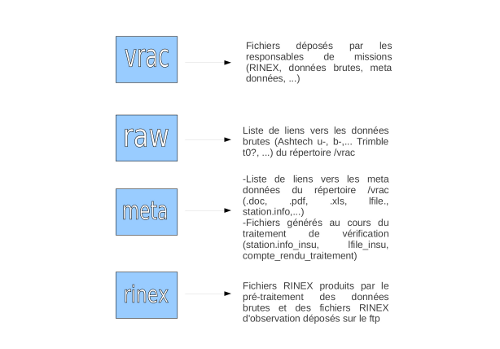Accueil > Campagnes > Archiving data from measurement campaigns performed with the INSU mobile pool of GNSS receivers
Rechercher
Archiving data from measurement campaigns performed with the INSU mobile pool of GNSS receivers
par -
Measurement campaign data are deposited by mission leaders on the ftp set-up at the Technical Division and then undergo verification and automatic archiving.
Raw data (Ashtech u-, b-, Trimble t0_) are converted into RINEX files. These files span less than a day, the standard naming system is adhered to, and when two files cover the same period, only the narrowest sampling is conserved. These RINEX files are deposited in the /rinex folder.
When the data sent are RINEX files, the pre-treatment consists in creating files containing the data for a single day and adhering to the standard nomenclature and format. These files are deposited in the /rinex folder.
Data conversion and pre-treatment are performed using TEQC software.
The RINEX files are treated using the sh_gamit programme. Some prior verification is necessary :
– When the coordinates are not clearly indicated, they are calculated by TEQC.
– The treatment script can be used to “send†the type of antenna used as a default argument for data treatment when it is not present in the RINEX file header. The default antenna is chosen based on the antennae borrowed from the instrument suite for the mission.
– An ASHTECH UZ-12-type receiver is used by default.
– During treatment, the nearest 5 IGS stations are added to the measurement campaign network (thanks to the prior calculation of the coordinates of the central point of the network made up of the stations measured during the campaign).
– A filter is used to exclude data from the IGS stations from treatment when these data have been deposited on the ftp.
Following this verification process :
– The RINEX files are transformed into Hatanaka format and compressed for storage on the gpscope server. A filter is applied to avoid archiving data from permanent stations which are already stored on the server.
– A MySQL database is populated. This database lists every point with its coordinates (in decimal degrees and in degrees, minutes, seconds), and each file with its start and end epochs, its access pathway and whether it has been validated or not by GAMIT treatment.
– Three metadata files are generated and stored in the /meta folder. One contains the coordinates indicated for the stations (lfile.), a station.info-type file and a file summarising how the treatment was applied (highlighting any use of “default†parameters for the treatment, rejection of some sites by GAMIT, the IGS stations used, etc.). The /meta folder also contains a list of links towards metadata files present in the bulk folder and deposited on the ftp by the mission leader (file types :.doc,.xls,.ps,.pdf,.apr, itrf, station.info, lfile).
– Similarly, when raw data are supplied, the /ram folder contains a list of links to the files present in the /vrac (bulk) folder.
Ultimately, a tool will be developed to return a list of RINEX campaign files present on the server (freely-accessible or not) in response to a request including the following arguments : a central point, a radius of investigation and a time range.

Dans la même rubrique :


